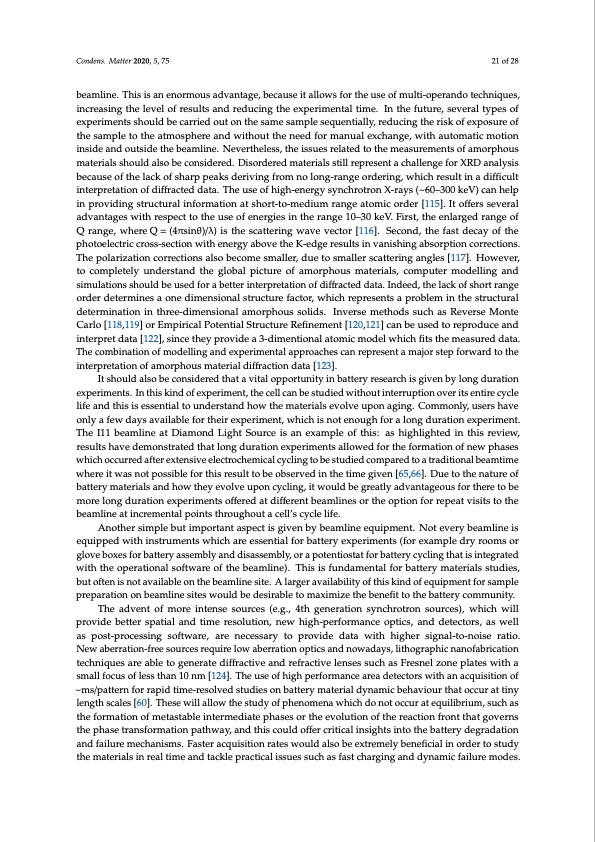
PDF Publication Title:
Text from PDF Page: 021
Condens. Matter 2020, 5, 75 21 of 28 beamline. This is an enormous advantage, because it allows for the use of multi-operando techniques, increasing the level of results and reducing the experimental time. In the future, several types of experiments should be carried out on the same sample sequentially, reducing the risk of exposure of the sample to the atmosphere and without the need for manual exchange, with automatic motion inside and outside the beamline. Nevertheless, the issues related to the measurements of amorphous materials should also be considered. Disordered materials still represent a challenge for XRD analysis because of the lack of sharp peaks deriving from no long-range ordering, which result in a difficult interpretation of diffracted data. The use of high-energy synchrotron X-rays (~60–300 keV) can help in providing structural information at short-to-medium range atomic order [115]. It offers several advantages with respect to the use of energies in the range 10–30 keV. First, the enlarged range of Q range, where Q = (4πsinθ)/λ) is the scattering wave vector [116]. Second, the fast decay of the photoelectric cross-section with energy above the K-edge results in vanishing absorption corrections. The polarization corrections also become smaller, due to smaller scattering angles [117]. However, to completely understand the global picture of amorphous materials, computer modelling and simulations should be used for a better interpretation of diffracted data. Indeed, the lack of short range order determines a one dimensional structure factor, which represents a problem in the structural determination in three-dimensional amorphous solids. Inverse methods such as Reverse Monte Carlo [118,119] or Empirical Potential Structure Refinement [120,121] can be used to reproduce and interpret data [122], since they provide a 3-dimentional atomic model which fits the measured data. The combination of modelling and experimental approaches can represent a major step forward to the interpretation of amorphous material diffraction data [123]. It should also be considered that a vital opportunity in battery research is given by long duration experiments. In this kind of experiment, the cell can be studied without interruption over its entire cycle life and this is essential to understand how the materials evolve upon aging. Commonly, users have only a few days available for their experiment, which is not enough for a long duration experiment. The I11 beamline at Diamond Light Source is an example of this: as highlighted in this review, results have demonstrated that long duration experiments allowed for the formation of new phases which occurred after extensive electrochemical cycling to be studied compared to a traditional beamtime where it was not possible for this result to be observed in the time given [65,66]. Due to the nature of battery materials and how they evolve upon cycling, it would be greatly advantageous for there to be more long duration experiments offered at different beamlines or the option for repeat visits to the beamline at incremental points throughout a cell’s cycle life. Another simple but important aspect is given by beamline equipment. Not every beamline is equipped with instruments which are essential for battery experiments (for example dry rooms or glove boxes for battery assembly and disassembly, or a potentiostat for battery cycling that is integrated with the operational software of the beamline). This is fundamental for battery materials studies, but often is not available on the beamline site. A larger availability of this kind of equipment for sample preparation on beamline sites would be desirable to maximize the benefit to the battery community. The advent of more intense sources (e.g., 4th generation synchrotron sources), which will provide better spatial and time resolution, new high-performance optics, and detectors, as well as post-processing software, are necessary to provide data with higher signal-to-noise ratio. New aberration-free sources require low aberration optics and nowadays, lithographic nanofabrication techniques are able to generate diffractive and refractive lenses such as Fresnel zone plates with a small focus of less than 10 nm [124]. The use of high performance area detectors with an acquisition of ~ms/pattern for rapid time-resolved studies on battery material dynamic behaviour that occur at tiny length scales [60]. These will allow the study of phenomena which do not occur at equilibrium, such as the formation of metastable intermediate phases or the evolution of the reaction front that governs the phase transformation pathway, and this could offer critical insights into the battery degradation and failure mechanisms. Faster acquisition rates would also be extremely beneficial in order to study the materials in real time and tackle practical issues such as fast charging and dynamic failure modes.PDF Image | Synchrotron-Based X-ray Diffraction for Lithium-Ion Batteries

PDF Search Title:
Synchrotron-Based X-ray Diffraction for Lithium-Ion BatteriesOriginal File Name Searched:
condensedmatter-05-00075.pdfDIY PDF Search: Google It | Yahoo | Bing
Sulfur Deposition on Carbon Nanofibers using Supercritical CO2 Sulfur Deposition on Carbon Nanofibers using Supercritical CO2. Gamma sulfur also known as mother of pearl sulfur and nacreous sulfur... More Info
CO2 Organic Rankine Cycle Experimenter Platform The supercritical CO2 phase change system is both a heat pump and organic rankine cycle which can be used for those purposes and as a supercritical extractor for advanced subcritical and supercritical extraction technology. Uses include producing nanoparticles, precious metal CO2 extraction, lithium battery recycling, and other applications... More Info
| CONTACT TEL: 608-238-6001 Email: greg@infinityturbine.com | RSS | AMP |